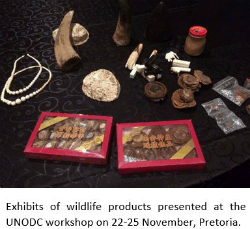Wildlife Crime: Following the money to combat a regional scourge
 Southern African countries are being challenged by increased wildlife crime levels. Organised syndicates, mainly from South-East Asian countries working together with local counterparts have established highly organised routes to traffic wildlife products to South-East Asia. There is a mistaken belief that these products possess medicinal powers and are considered high status symbols. These beliefs continue to fuel this illegal trade.
Southern African countries are being challenged by increased wildlife crime levels. Organised syndicates, mainly from South-East Asian countries working together with local counterparts have established highly organised routes to traffic wildlife products to South-East Asia. There is a mistaken belief that these products possess medicinal powers and are considered high status symbols. These beliefs continue to fuel this illegal trade.
As reported at the recent conference of the Convention on International Trade in Endangered Species of Wild Fauna and Flora (October 2016, Johannesburg, South Africa) in the last 3 years over 3,394 rhino horns have been poached in South Africa alone. Figures for poaching in 2016 have not yet been released, but an increase is expected in the Southern African region.
A recent example of the problem that is being faced by South Africa was reported on 24 November 2016 by SABC Breaking News as follows:
 "A Chinese national has been arrested in connection with the crime. "A Chinese national has been arrested in connection with the crime.
He is expected to appear in the Kempton Park Magistrate's Court on Friday. Members of the Directorate for Priority Crime Investigation at the airport acted on a tip-off. "The 28-year-old male, who was in transit from Namibia, was about to board a South African Airways flight to Hong Kong on Wednesday afternoon when he was stopped and searched," police said. "Upon the search, police recovered 18 rhino horns inside his luggage weighing 43kg with an estimated value of R6.6 million." |
It is against this backdrop that on 22-25 November in Pretoria the UNODC ROSAF organized a regional workshop for practitioners from financial intelligence units and law enforcement authorities from Botswana, Malawi, Mozambique, Namibia, Seychelles, South Africa and Zambia. The participants worked through real-life case studies on:
- How to investigate wildlife trafficking cases by effectively conducting a parallel financial investigation;
- How to address gaps and vulnerabilities during the investigation, by benefiting from the experience shared by others countries (multidisciplinary and joint operations);
- How to investigate complex financial crimes (money laundering), in relation to a wildlife case, including the importance of concentrating on the proceeds of crime and asset forfeiture; and
- How to use regional best practices for the purpose of ensuring effective cooperation at the national level, and exchange of information between competent authorities, in particular between law enforcement bodies, customs and FIUs of participating countries.
As discussed at the conference, the national authorities would need to develop an inter-agency approach in order to effectively address the increase in wildlife trafficking in the region. This new approach would mean that as well as confiscating physical objects such as money, drugs and rhino horns, there would be focus on tracking and seizing the proceeds of crime from the criminal syndicates.
As highlighted by participants, "it is only by looking beyond the poacher and identifying the financial flows of the criminal networks and syndicates and by locating and seizing the proceeds of crime will reinvestment in these crimes be prevented."